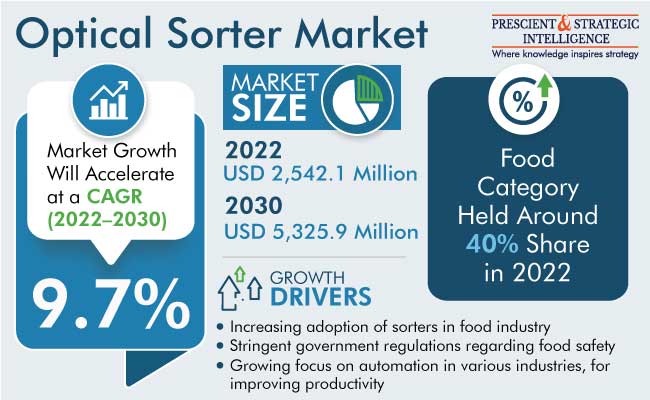Optical Sorter Market is Dominated by the Camera Category
The optical sorter market generated a value of USD 2,542.1 million in 2022, and it will touch USD 5,325.9 million, advancing at a 9.7% compound annual growth rate, by 2030.
The growth of the optical sorter industry is ascribed to factors such as, the strict government regulations concerning food safety, the increasing emphasis on automation in numerous industries to enhance productivity, and the mounting usage of sorters in the mining, food, pharmaceutical, and recycling industries.
With rapid technological advancements, optical sorters have become integral to achieving substantial economic benefits. These machines play an important role in ensuring food safety and elevating health standards by eliminating the potential diseases associated with recycled materials or manual sorting of waste.
Moreover, numerous industries have experienced the advantages of technological advancements in optical sorters, as they are applied to identify and separate different items.
In 2022, the food category, based on application, accounted for the largest revenue share in the optical sorter industry, of 40%. This is credited to the fact that the food industry is the backbone of numerous economies and plays an important role in day-to-day life.
A key use area of optical sorters in the food industry is the evaluation of fruits, vegetables, grains, processed foods, and dry fruits. In addition, modern sorters have the ability to assess insect infestation and toxins in fruits, vegetables, and grains.
Furthermore, optical sorters are also used increasingly in the processes of recycling. For example, in the process of plastic recycling units, it is used to identify plastics in general, as well as to separate plastics into different categories based on their shape, composition, and color.
In 2022, the camera category accounted for the largest optical sorter market revenue share, of 45%, based on type. This is primarily because of the existence of a 360° camera view, which offers easy and effective ongoing processes inspection.
In 2022, the belt category, based on platform, accounted for the largest revenue share of the industry. This is mainly attributed to the fact that belt platforms are primarily ideal for applications of higher-capacity, for instance, vegetable products before canning, drying, or freezing.
In 2022, the North American optical sorter industry accounted for the largest revenue share, of 35%. This is mainly because of the growing number of recycling, mining, and food processing activities in the region.
It is because of the growing usage of sorters in the food industry, strict regulations of government concerning food safety, and increasing emphasis on automation in several industries to enhance productivity, the global optical sorter industry will continue to advance in the years to come.
Read More:
https://www.psmarketresearch.com/market-analysis/optical-sorter-market
Optical Sorter Market is Dominated by the Camera Category
The optical sorter market generated a value of USD 2,542.1 million in 2022, and it will touch USD 5,325.9 million, advancing at a 9.7% compound annual growth rate, by 2030.
The growth of the optical sorter industry is ascribed to factors such as, the strict government regulations concerning food safety, the increasing emphasis on automation in numerous industries to enhance productivity, and the mounting usage of sorters in the mining, food, pharmaceutical, and recycling industries.
With rapid technological advancements, optical sorters have become integral to achieving substantial economic benefits. These machines play an important role in ensuring food safety and elevating health standards by eliminating the potential diseases associated with recycled materials or manual sorting of waste.
Moreover, numerous industries have experienced the advantages of technological advancements in optical sorters, as they are applied to identify and separate different items.
In 2022, the food category, based on application, accounted for the largest revenue share in the optical sorter industry, of 40%. This is credited to the fact that the food industry is the backbone of numerous economies and plays an important role in day-to-day life.
A key use area of optical sorters in the food industry is the evaluation of fruits, vegetables, grains, processed foods, and dry fruits. In addition, modern sorters have the ability to assess insect infestation and toxins in fruits, vegetables, and grains.
Furthermore, optical sorters are also used increasingly in the processes of recycling. For example, in the process of plastic recycling units, it is used to identify plastics in general, as well as to separate plastics into different categories based on their shape, composition, and color.
In 2022, the camera category accounted for the largest optical sorter market revenue share, of 45%, based on type. This is primarily because of the existence of a 360° camera view, which offers easy and effective ongoing processes inspection.
In 2022, the belt category, based on platform, accounted for the largest revenue share of the industry. This is mainly attributed to the fact that belt platforms are primarily ideal for applications of higher-capacity, for instance, vegetable products before canning, drying, or freezing.
In 2022, the North American optical sorter industry accounted for the largest revenue share, of 35%. This is mainly because of the growing number of recycling, mining, and food processing activities in the region.
It is because of the growing usage of sorters in the food industry, strict regulations of government concerning food safety, and increasing emphasis on automation in several industries to enhance productivity, the global optical sorter industry will continue to advance in the years to come.
Read More: https://www.psmarketresearch.com/market-analysis/optical-sorter-market





